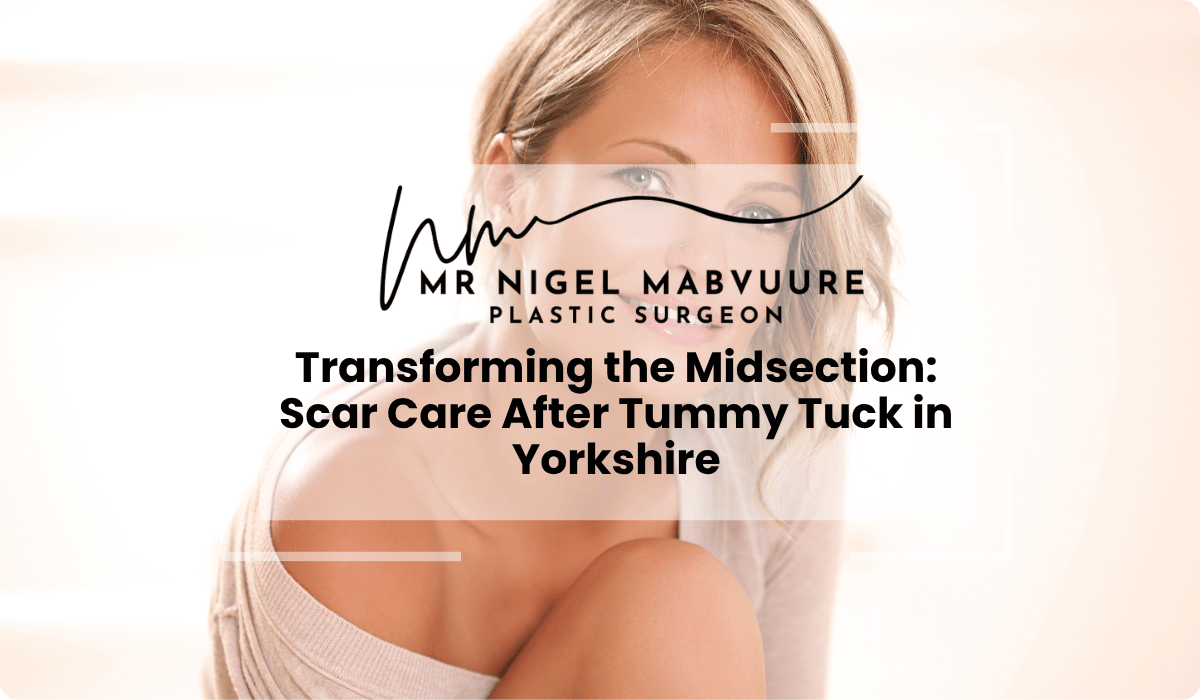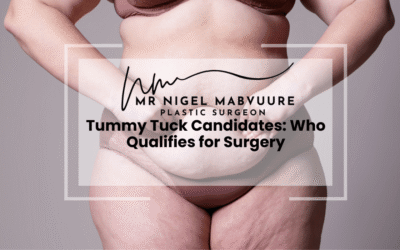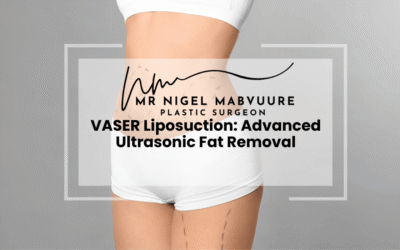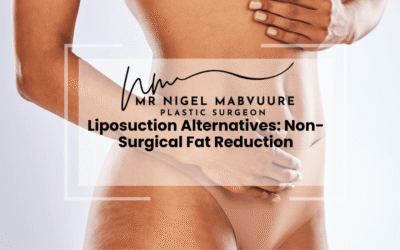Managing Your Tummy Tuck Scar Journey
- Tummy tuck scars typically run horizontally from hip to hip, positioned low enough to be concealed beneath underwear or swimwear.
- The complete healing timeline spans 12-24 months, with the most significant improvements occurring between 6-12 months post-surgery.
- Evidence-based scar care techniques include silicone products, gentle massage, strict sun protection, and compression garments.
- While tummy tuck scars fade significantly with time and proper care, complete invisibility is not a realistic expectation.
- Professional treatments available in Yorkshire include laser therapy, steroid injections, microneedling, and scar revision surgery for challenging cases.
- Monitor for red flags during healing: increasing redness, unusual warmth, discharge, wound separation, or excessive raised scarring.
- Patient experiences highlight that consistent scar care, early intervention for complications, and realistic expectations lead to the most satisfying outcomes.
Table of Contents
- Understanding Tummy Tuck Scars: What to Expect in Yorkshire
- The Complete Timeline of Abdominoplasty Scar Healing
- Essential Scar Care Techniques for Optimal Healing Results
- How Long Do Tummy Tuck Scars Take to Fade Completely?
- Professional Scar Treatments Available in Yorkshire
- Preventing Complications: Red Flags During Scar Healing
- Yorkshire Patient Stories: Real Tummy Tuck Scar Journeys
Understanding Tummy Tuck Scars: What to Expect in Yorkshire
Abdominoplasty, commonly known as a tummy tuck, is a transformative procedure that many Yorkshire residents choose to restore their midsection contour. While the results can be life-changing, understanding the scarring process is essential for patients considering this surgery. In Yorkshire, where experienced plastic surgeons offer advanced techniques, patients can expect a horizontal scar that typically runs from hip to hip, positioned low enough to be concealed beneath underwear or swimwear.
The nature of tummy tuck scars depends largely on the type of procedure performed. A full abdominoplasty creates a longer horizontal scar and often includes a small scar around the navel. Mini tummy tucks, increasingly popular in Yorkshire clinics, result in shorter scars limited to the lower abdomen. Extended tummy tucks, which address more extensive skin laxity, may create longer scars extending toward the flanks.
Yorkshire surgeons typically employ meticulous closure techniques to minimise scarring, including layered suturing that reduces tension on the skin. Initially, your scar will appear red and raised, which is completely normal. Understanding that scarring is an inevitable part of the healing process helps set realistic expectations for your abdominoplasty journey in Yorkshire.
The Complete Timeline of Abdominoplasty Scar Healing
The healing journey for tummy tuck scars follows a predictable timeline, though individual experiences may vary based on personal factors. Understanding this progression helps Yorkshire patients prepare mentally for their recovery process.
Weeks 1-2: Initial Healing Phase
Immediately after surgery, your incision will be covered with dressings. Once removed, you’ll notice the scar appears red, possibly raised, and may feel tight or uncomfortable. During this phase, the body is actively forming a protective layer over the wound.
Weeks 3-6: Early Maturation
As healing progresses, the scar may become darker and more pronounced before it begins to improve. This is normal and part of the inflammatory response. The scar might appear purple or dark red during this stage, and the surrounding tissue may feel firm.
Months 2-3: Continued Improvement
By this point, the scar begins to flatten and fade slightly. The redness gradually diminishes, though the scar remains visible. Most Yorkshire patients can resume normal activities, including swimming and exercise, which may actually help improve circulation to the healing tissues.
Months 6-12: Significant Fading
This marks a turning point in scar maturation. The scar typically becomes softer, flatter, and lighter in colour. While still visible, it’s considerably less noticeable than in earlier stages.
Beyond 12 Months: Long-term Appearance
After the one-year mark, most tummy tuck scars have reached their final appearance. For many Yorkshire patients, the scar fades to a thin, pale line that’s easily concealed. However, complete invisibility is not a realistic expectation for most abdominoplasty patients.
Essential Scar Care Techniques for Optimal Healing Results
Proper scar care is crucial for achieving the best possible aesthetic outcome after your tummy tuck in Yorkshire. Following these evidence-based techniques can significantly improve the appearance of your abdominoplasty scar:
Keep Incisions Clean and Protected
During the initial healing phase, gently cleanse the incision area as directed by your Yorkshire surgeon. Avoid harsh soaps or scrubbing motions. Pat the area dry rather than rubbing, and follow your surgeon’s instructions regarding dressing changes and shower protocols.
Silicone-Based Products
Silicone sheets or gels are considered the gold standard in scar management. These products create a protective barrier that hydrates the scar tissue while reducing collagen production. Many Yorkshire plastic surgeons recommend beginning silicone therapy once the incision has fully closed, typically around 2-3 weeks post-surgery.
Scar Massage
Once your surgeon gives approval (usually after 3-4 weeks), gentle massage of the scar can help break down adhesions and improve flexibility. Using a non-perfumed moisturiser or vitamin E oil, use your fingertips to apply gentle pressure in circular motions along the scar for 5-10 minutes daily.
Sun Protection
Newly formed scars are highly susceptible to UV damage, which can cause permanent darkening. When in Yorkshire’s variable climate, always apply SPF 30+ sunscreen to your scar when exposed, even on cloudy days. Consider protective clothing as an additional barrier during the first year post-surgery.
Compression Garments
Your surgeon will likely recommend wearing a compression garment for several weeks after surgery. This not only supports your abdomen but also helps minimise swelling and promotes proper scar formation by reducing tension on the healing tissues.
Consistent application of these techniques, combined with following your Yorkshire surgeon’s specific aftercare protocol, creates the optimal environment for scar healing and minimisation. Remember that patience is key—scar improvement is a gradual process that continues for many months after your procedure.
How Long Do Tummy Tuck Scars Take to Fade Completely?
One of the most common questions Yorkshire patients ask is about the timeline for scar fading. The truth is that tummy tuck scars never disappear completely, but they do typically fade significantly with proper care and time. Understanding the realistic expectations for scar fading helps patients prepare mentally for their abdominoplasty journey.
Most tummy tuck scars undergo their most dramatic improvement between 6 and 12 months post-surgery. During this period, the redness diminishes considerably, and the scar begins to flatten and lighten. By the one-year mark, many Yorkshire patients report being pleasantly surprised by how much their scar has faded.
The scar maturation process continues beyond the first year, albeit at a slower pace. Between years 1-2, further softening and fading occur, with the scar often settling into its final appearance by the end of the second year. At this stage, most abdominoplasty scars have transformed from the initially vivid red line to a thin, pale mark that’s significantly less noticeable.
It’s important to note that complete invisibility is not a realistic expectation for tummy tuck scars. Even with optimal healing and the best surgical techniques available in Yorkshire, some degree of scarring will remain visible. However, the strategic placement of the incision below the bikini line means that most patients can confidently wear swimwear without their scar being visible.
Factors that influence how quickly and completely your scar fades include your skin type, age, genetics, adherence to scar care protocols, and whether any complications occurred during healing. Patients with darker skin tones may experience hyperpigmentation around the scar, while those with very fair skin might notice the scar remains slightly pink even after full maturation. Post-pregnancy patients often find that their healing timeline aligns with these general expectations, though individual results always vary.
Professional Scar Treatments Available in Yorkshire
For Yorkshire patients seeking to further improve the appearance of their tummy tuck scars beyond at-home care, several professional treatments are available. These interventions can be particularly beneficial for scars that remain prominent after the initial healing period or for patients with specific concerns about their scar’s appearance.
Laser Therapy
Several Yorkshire clinics offer advanced laser treatments specifically designed for scar reduction. Fractional laser therapy creates microscopic wounds in the scar tissue, stimulating collagen remodelling and improving texture. Pulsed dye lasers target the blood vessels within the scar, reducing redness and inflammation. Most patients require 3-5 sessions spaced several weeks apart for optimal results.
Steroid Injections
For hypertrophic or keloid scars that remain raised and thick, intralesional steroid injections can be highly effective. These injections, available at specialist dermatology clinics throughout Yorkshire, help flatten raised scars by breaking down excess collagen. Treatments are typically administered every 4-6 weeks until the desired improvement is achieved.
Microneedling
This minimally invasive procedure uses fine needles to create controlled micro-injuries in the scar tissue, triggering the body’s natural healing response. The resulting collagen production can improve scar texture and appearance. Yorkshire aesthetic clinics often combine microneedling with topical treatments like vitamin C or growth factors for enhanced results.
Scar Revision Surgery
In cases where the initial scar has healed poorly or is particularly wide, surgical revision may be recommended. Yorkshire plastic surgeons can excise the old scar and create a new, thinner closure. This option is typically considered only after the original scar has fully matured, usually at least 12 months post-abdominoplasty.
Medical-Grade Skincare
Dermatologist-prescribed skincare regimens containing ingredients like retinoids, niacinamide, and specific peptides can improve scar appearance over time. These prescription-strength products available through Yorkshire dermatology practices offer more potent formulations than over-the-counter alternatives.
Before pursuing any professional scar treatment, consult with your original surgeon or a dermatologist specialising in scar management. They can assess your specific scar characteristics and recommend the most appropriate interventions based on your healing progress and aesthetic goals.
Preventing Complications: Red Flags During Scar Healing
While most tummy tuck scars in Yorkshire patients heal without significant issues, being vigilant about potential complications can prevent long-term problems. Recognising the warning signs early allows for prompt intervention, potentially saving you from more serious scar-related concerns.
Infection Warning Signs
Infection can significantly impair scar healing and lead to wider, more noticeable scars. Watch for increasing redness that extends beyond the immediate scar area, unusual warmth, throbbing pain, pus or discharge, and fever. Yorkshire patients noticing these symptoms should contact their surgeon immediately, as early antibiotic treatment can prevent infection from compromising your results.
Dehiscence (Wound Separation)
Excessive tension or movement during early healing can cause the incision to partially open. Signs include a gap in the incision line or visible deeper tissues. This complication requires urgent medical attention to prevent further opening and potential infection. Following your surgeon’s activity restrictions is crucial for Yorkshire patients to avoid this complication.
Hypertrophic Scarring and Keloids
Some patients are genetically predisposed to developing raised, thick scars. Early signs include a scar that continues to become more raised, red, and firm beyond the normal healing timeline. If you notice your scar becoming increasingly prominent after 3-4 months, consult your Yorkshire surgeon, as early intervention with silicone therapy or steroid injections can help manage these concerns.
Persistent Drainage
While some clear fluid drainage is normal in the first days after surgery, persistent drainage, especially if cloudy or foul-smelling, may indicate a seroma or infection. Yorkshire patients experiencing ongoing drainage should have this assessed promptly to prevent complications that could affect scar appearance.
Excessive Tension
Feeling extreme tightness around your scar, especially if accompanied by blanching (whitening) of the skin when you move, may indicate problematic tension that could lead to widened scars or even tissue death. Your surgeon can evaluate whether interventions are needed to relieve this tension.
Remember that proper adherence to post-operative instructions is your best defence against complications. Yorkshire surgeons typically provide detailed guidance on activity restrictions, compression garment use, and wound care specifically designed to minimise these risks. When in doubt about any aspect of your healing, don’t hesitate to contact your surgical team for assessment.
Yorkshire Patient Stories: Real Tummy Tuck Scar Journeys
The experiences of fellow Yorkshire residents who have undergone abdominoplasty can provide valuable insights and realistic expectations for those considering the procedure. While every patient’s journey is unique, these anonymised stories highlight common themes in tummy tuck scar healing and management.
Sarah’s Journey: From Concern to Confidence
Sarah, a 42-year-old mother of three from Leeds, was initially alarmed by the appearance of her tummy tuck scar at six weeks post-surgery. “It was much redder and more noticeable than I expected,” she recalls. “I worried I’d made a mistake.” Following her surgeon’s advice, Sarah diligently applied silicone sheets and protected her scar from sun exposure. “By month nine, the transformation was remarkable. Now, two years later, the scar is a faint line that’s easily hidden by underwear. The improvement in my body confidence has been worth every moment of the healing process.”
James’s Experience: Managing Complications
James, 38, from York, developed a small area of hypertrophic scarring at one end of his abdominoplasty incision. “I noticed one section of my scar was becoming raised and redder than the rest around the three-month mark,” he explains. His surgeon recommended steroid injections, which he received at four-week intervals. “After three treatments, the raised area began to flatten. It took patience, but by 18 months post-surgery, even that problematic section had improved dramatically. I’m glad I addressed it early rather than waiting to see if it would improve on its own.”
Emma’s Perspective: The Role of Compression
Emma, 45, from Sheffield, attributes much of her excellent scar healing to strict adherence to compression garment guidelines. “Wearing the compression garment was uncomfortable, especially during Yorkshire’s warm summer months, but I followed my surgeon’s recommendation to wear it for eight weeks,” she shares. “I believe this made a significant difference in preventing scar widening. My scar remained narrow throughout the healing process and now, 15 months later, it’s barely noticeable even to me.”
Michael’s Insight: The Psychological Journey
Michael, 52, from Hull, emphasises the importance of the mental aspect of scar healing. “There’s a psychological process that parallels the physical healing,” he notes. “Initially, I was hyperfocused on my scar, checking it multiple times daily. As I gradually accepted it as part of my transformation journey, I actually noticed it less. Now I see it as a small
Frequently Asked Questions
How long will my tummy tuck scar be visible?
Tummy tuck scars are most noticeable during the first 3-6 months after surgery. They typically undergo significant fading between 6-12 months post-procedure, continuing to improve through the second year. While the scar never completely disappears, most patients find that by 18-24 months, it has matured into a thin, pale line that’s easily concealed beneath underwear or swimwear. Individual results vary based on genetics, skin type, and adherence to scar care protocols.
What is the best treatment for tummy tuck scars?
Silicone-based products (sheets or gel) are considered the gold standard for tummy tuck scar treatment. These should be combined with gentle scar massage once healing permits, diligent sun protection, and wearing compression garments as directed. For scars that remain problematic after 6-12 months, professional treatments like laser therapy, microneedling, or steroid injections may provide additional improvement. The most effective approach is typically a combination of consistent at-home care and professional treatments as needed.
Where exactly is the tummy tuck scar located?
A standard full tummy tuck scar runs horizontally across the lower abdomen, positioned low enough to be concealed by underwear or bikini bottoms. The incision typically extends from hip to hip, just above the pubic area. Most surgeons place this scar 5-7cm above the genital area, following the natural skin crease. Additionally, full abdominoplasty includes a small scar around the navel where it is repositioned. Mini tummy tucks result in shorter lower abdominal scars with no navel scarring.
Is it normal for my tummy tuck scar to be red and raised?
Yes, it’s completely normal for tummy tuck scars to appear red, raised, and possibly firm during the first several months of healing. This is part of the inflammatory phase of wound healing. The redness and elevation typically peak around 6-8 weeks post-surgery before gradually improving. If your scar remains significantly raised, increasingly red, or becomes itchy beyond 3-4 months, consult your surgeon as these could be signs of hypertrophic scarring that may benefit from early intervention.
Can tummy tuck scars become infected?
Yes, tummy tuck incisions can develop infections, particularly during the first few weeks after surgery. Warning signs include increasing redness extending beyond the immediate scar area, unusual warmth, throbbing pain, pus or discharge, and fever. Prompt treatment with antibiotics is essential to prevent the infection from compromising your aesthetic results. Following your surgeon’s wound care instructions carefully, keeping the incision clean and dry, and avoiding swimming until fully healed helps minimize infection risk.
Will pregnancy after a tummy tuck ruin my scar?
Pregnancy after a tummy tuck will likely stretch the abdominal skin and may affect the appearance of your scar. The scar itself may widen or change in texture as the skin expands to accommodate the growing baby. Additionally, the overall aesthetic improvements achieved through abdominoplasty may be compromised. For this reason, most surgeons recommend postponing tummy tuck surgery until you’ve completed your family planning. If you do become pregnant after a tummy tuck, a revision procedure might be needed to restore your results.
How can I tell if my tummy tuck scar is healing properly?
A normally healing tummy tuck scar progresses through predictable stages. Initially, it appears red and slightly raised with possible mild drainage. By 2-3 weeks, the incision should be fully closed with no drainage. Between 1-3 months, the scar remains red but should not be getting increasingly raised or spreading. From 3-6 months, you should notice gradual fading of redness and softening of the scar tissue. Any signs of widening gaps, increasing pain, spreading redness, or persistent firmness beyond these timeframes warrant consultation with your surgeon.




